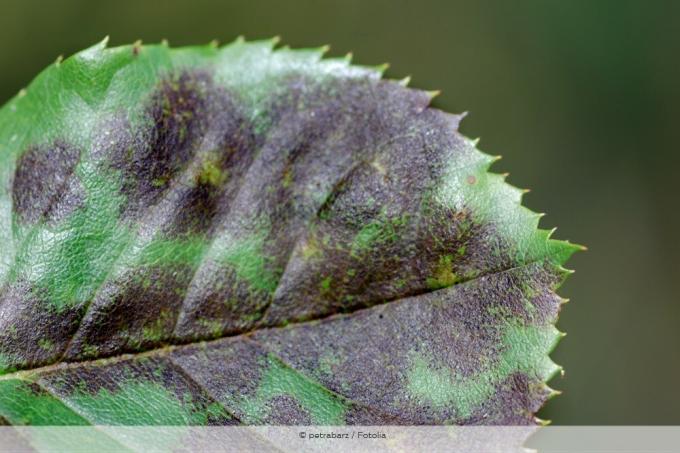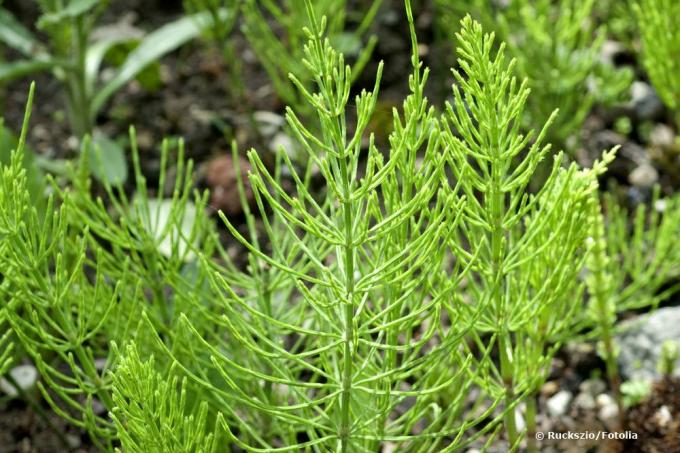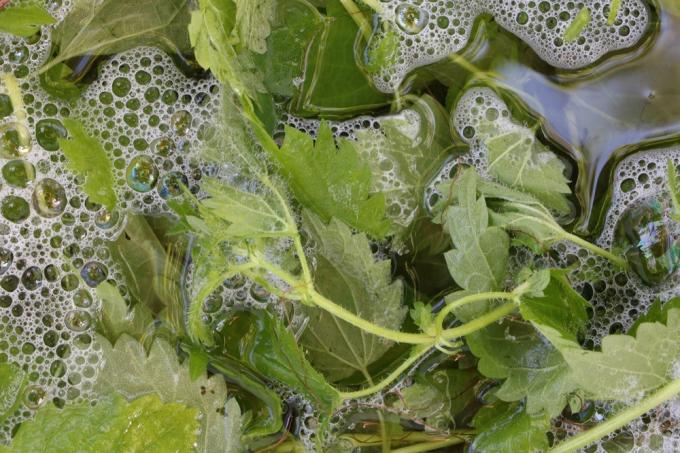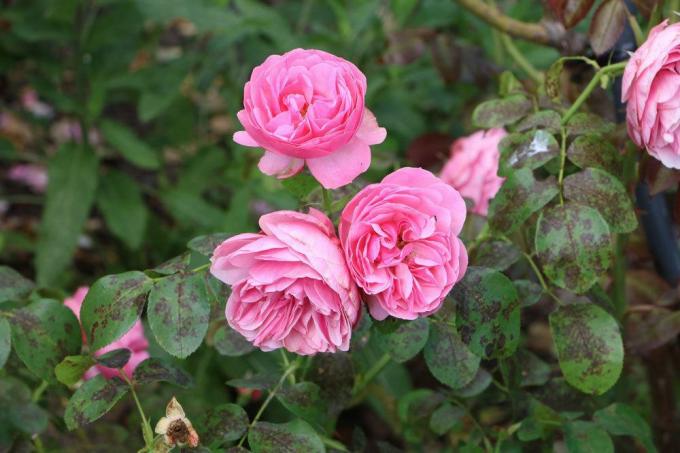
table of contents
- Rose disease: black starch
- Damage image
- Course of disease
- Affected rose varieties
- Preventive measures
- Countermeasures
- Home remedies
- Horsetail (field horsetail)
- Comfrey
- garlic
- Nettle manure
If rose petals get black spots with a yellow halo, it is usually an infestation with star soot. The fungus is extremely persistent and affects almost all types of roses. Therefore, you should take preventive measures to protect the plants from this rose disease. If the fungus has already infected the rose, control must be started immediately. Preferably before the rose petals have turned completely yellow.
Rose disease: black starch
Yellow leaves with black spots
If the leaves of your roses turn yellow and develop black spots, then it is usually the rose disease black soot. The black star soot (Diplocarpon rosae) is a hose fungus from the genus Diplocarpon that survives a mild winter well. He prefers to overwinter
- in the ground
- on old, infested leaves
- on old, infested shoots

Damage image
While fighting black spot disease, as the fungal infection is also known, is difficult, spotting it is pretty easy:
- round, black spots on the upper side of the leaf
- often spread out in a star shape
- are unevenly distributed
- form concentric circles
- have a fuzzy edge
- yellow discoloration around the black spots
- Leaves turn yellow
- fall off prematurely
The fungus, more precisely the fungal spores, sit in the black spots and are responsible for the fungus to spread on the plant. Their spread is favored by spray water, insects, wind or cultivation measures that weaken the plant (e. B. a compacted soil).
Course of disease
As a rule, black spot disease begins on the lower leaves of the rose. So they turn yellow first. This is due to the fact that the fungal spores are "sprayed" onto the leaves by irrigation or rainwater hitting the ground. From there they spread over the whole plant, including to neighboring rose bushes. Since infected resp. If lost leaves of the rose are missing during the metabolism and energy change (assimilation), it is weakened more and more in the course of the disease. When sick, it can no longer develop new flowers and new shoots no longer mature. Since only incomplete ripening takes place, the resistance of the rose bushes to frost is also reduced.
tip: In rare cases, immature, annual shoots are also attacked by the fungus. Initially, purple-red spots form, which then turn black as the disease progresses.
Temporal course of the disease
The first symptoms of this rose disease show up as early as April or May. How quickly the infection spreads, i.e. the spots appear and the leaves turn yellow, depends, among other things, on the variety. It may well be that some rose varieties have already lost all of their leaves in midsummer. Temperatures above 15 ° C, wet weather and high humidity promote the spread of the infection.
Once the fungus has started to become infected, the first symptoms appear after 3 to 16 days, depending on the temperature and humidity. The fungus spreads after 10 to 18 days under conditions that are optimal for the fungus.
Affected rose varieties
Star soot generally attacks all roses. However, they are particularly at risk Shrub roses. The mushroom also does not stop at roses, which are cultivated as house plants. Since the mushroom also other house and garden plants, such as laurel or oleander, infected, the roses can also be infected via these neighboring plants.
tip: Rose varieties that are resistant to star soot are, for example, "Angela", "Dortmund" or "Yellow Dagmar".
Preventive measures
Since the control of star soot is very difficult, you should prevent an infection so that the plants do not get sick in the first place. Preventive measures include:
- Choice of location
- Pouring behavior
- Nutrient supply
- care
Choice of location
Mushrooms like it warm and humid. Therefore, a sunny and airy location helps the plants. Choose the location so that the roses can dry off well overnight, even when it rains.
Note: Damp and shady locations favor rose disease.
Pouring behavior
When watering the roses, make sure that the rose petals are not wetted. It is best to water roses so that the water does not splash on the lower leaves. Avoid watering the roses in the late evening hours as the plants cannot dry off overnight in cooler temperatures.
Nutrient supply
Avoid nitrogen-based fertilization. A balanced one Potash fertilization on the other hand, increases the resistance of the roses to the starch soot. Silicic acid, which can be administered through horsetail tea, strengthens the cell walls of the leaves, thereby greatly reducing the triggering of the infection.
tip: Use these plant strengtheners from the beginning of May. Plants that were not infected with the fungus in the previous year should also receive this strengthening in order to increase their resistance.
care
When caring for it, it is important to remove any leaves that have not naturally fallen in autumn. You should also carefully remove any leaves lying on the ground. This is how you deprive the fungus of wintering opportunities. In the spring you should remove any leaves, whether green or yellow, that have remained on the plant through the winter.
tip: If the rose was already infected, the leaves must not be disposed of on the compost Fungal spores survive there and the roses become infected with the rose disease when the compost is dumped will.
So that the rose can dry well and light can penetrate into the inside of the stick, you should cut and light it regularly.
Countermeasures
If the black spot disease shows up, the infected rose petals must be removed before they have turned completely yellow and disposed of with household waste. The tool used should be disinfected after each work step so that the fungus does not spread through it. To disinfect, immerse the cutting tool in alcohol for about five minutes and then flame it off with a lighter. To further combat the fungus, you can use special fungicides from specialist shops or home remedies.
Home remedies
The home remedies described below can also be used as preventive measures against blackened soot. It is important that you spray the plants when the sky is overcast and that you usually repeat the process several times at intervals of one to two weeks.
Horsetail (field horsetail)
Horsetail are given as tea, broth or liquid manure, which provide the leaves with valuable silica to strengthen the cell walls. For broth or tea you need one kilogram of fresh horsetail for ten liters of water. Proceed as follows:

tea
Pour boiling water over the horsetail and let it steep for ten minutes. Then strain.
broth
Soak horsetail in cold water for 24 hours. Then cook for 30-60 minutes. Then let it steep for 24 hours and then strain.
Dilute tea and broth with water in a ratio of 1: 5 for spraying.
Comfrey
Comfrey is high in potassium. You can mulch with comfrey leaves or sprinkle the roses with diluted comfrey broth.
tip: Do not mulch directly under the roses, because the fungus can develop wonderfully there.
garlic
For a garlic broth or For a garlic stock you need 75 grams of coarsely chopped garlic and a liter of water. To make it, proceed as follows:
- Bring the garlic to the boil in the water
- cover
- Let it steep for 10 to 15 minutes
- Dilute the batch in a ratio of 1:10 with water
Application: Spray roses three times in a row with the garlic broth three days apart.
Nettle manure
For making Nettle manure Do you need:
- one kilogram of fresh, finely chopped nettle (or 200 grams of dried)
- Barrel or container made of wood, earthenware, plastic
- 10 liters of water
- Lid for the container
- Stick for stirring
Put the nettles with the water in the container and place it in a sunny spot. Cover the barrel with the lid. Stir the mixture with the stick every day. The fermentation process is completed after one to two weeks. The liquid manure is ready when there is no more foam and the liquid has turned dark. Apply the liquid manure in a ratio of 1:10 every week.




